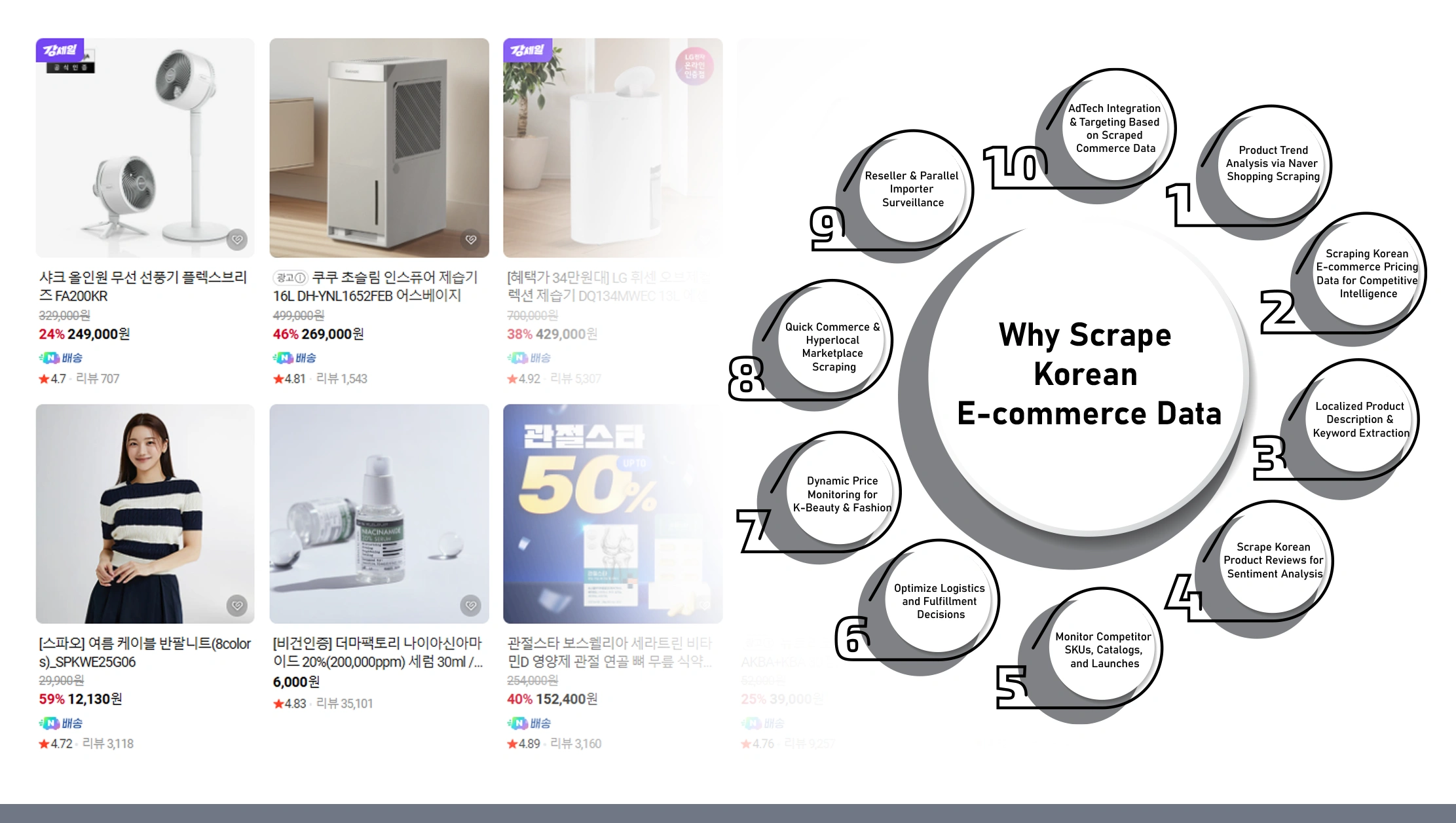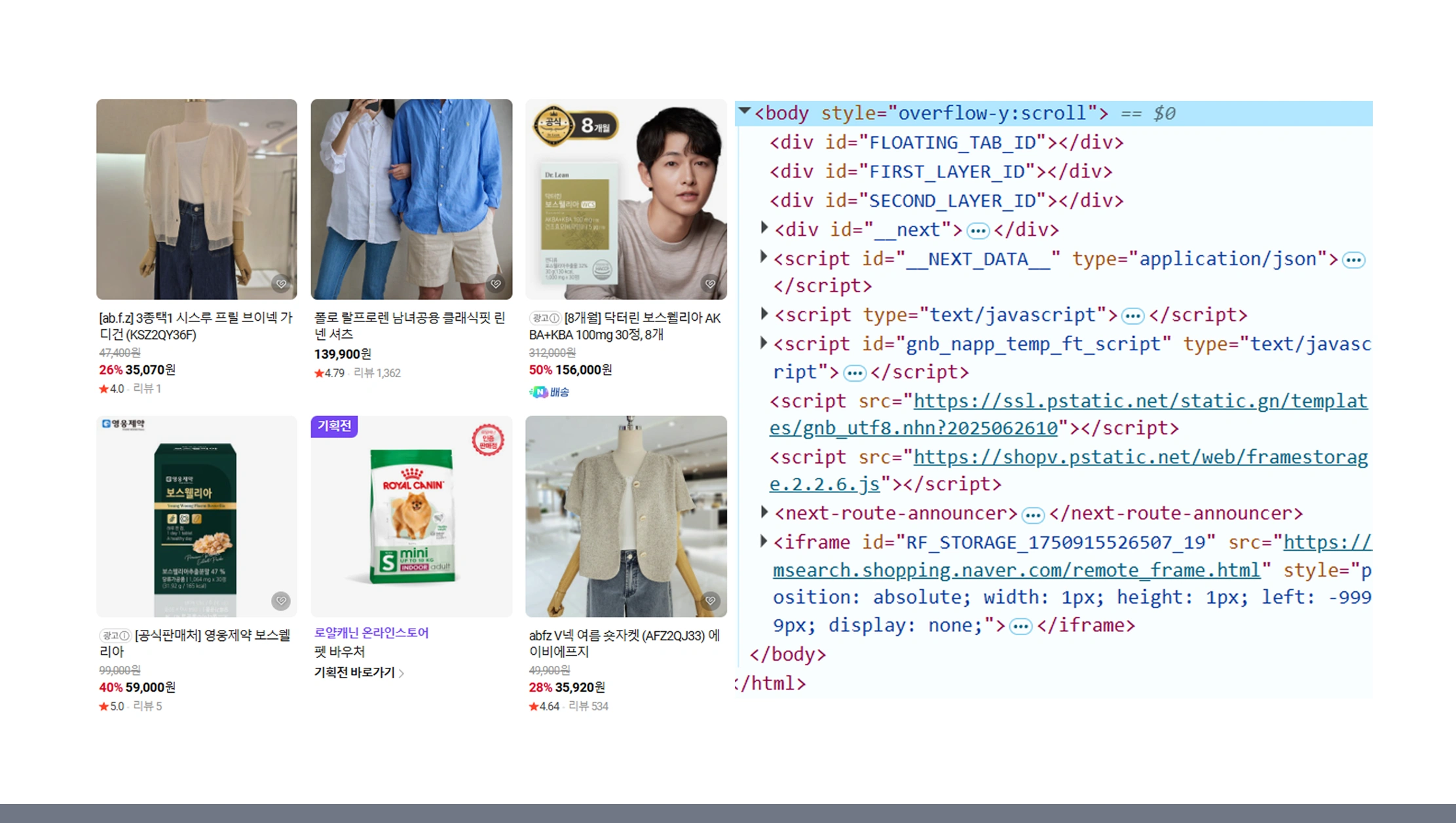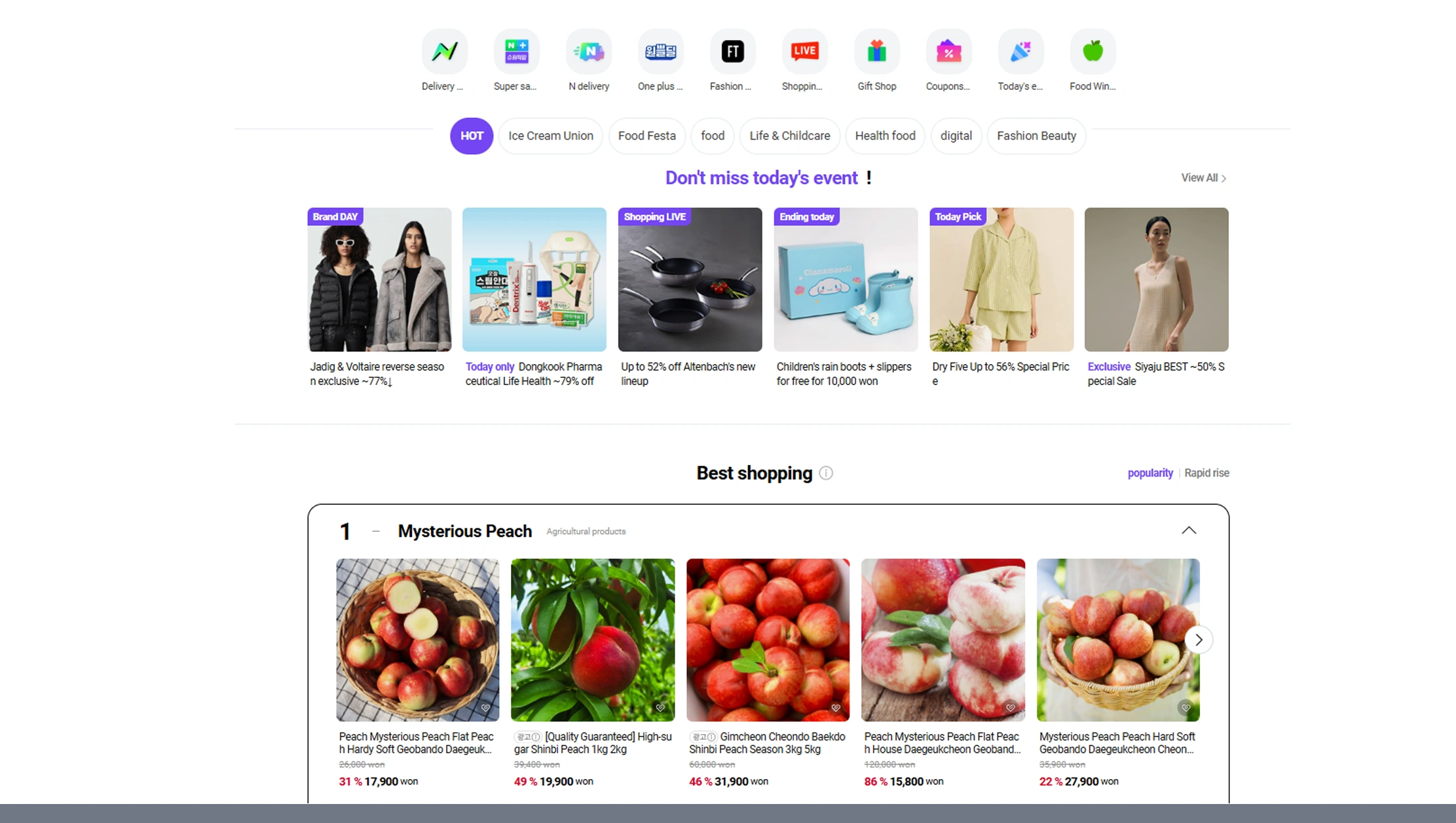

Introduction
South Korea has evolved into a global powerhouse in digital commerce. With leading platforms like Naver Shopping, Coupang, Gmarket, and 11Street, the Korean e-commerce landscape is vibrant, competitive, and data-rich. For global brands and cross-border sellers, tapping into this market isn't just about launching a localized site — it's about gaining real-time insights, which is only possible through scraping Korean E-commerce Data APIs.
A well-implemented Korean E-commerce Data API gives businesses access to vital data on products, pricing, reviews, and seller performance across major Korean marketplaces. Whether you’re tracking trending SKUs, customer sentiment, or daily price fluctuations, this data is invaluable for market responsiveness.
In this blog, we explore the top use cases of scraping Korean E-commerce Data for companies aiming to enter or scale in South Korea. From dynamic pricing and product discovery to competitor benchmarking and demand forecasting, a robust Korea E-commerce API is the foundation of a smarter, faster, and more localized market entry strategy.
Why Scrape Korean E-commerce Data?

Before diving into use cases, here’s why brands are actively scraping Korean marketplaces:
- Language & localization challenges: Consumer behavior is tied to culture, context, and local language. Scraped data helps bridge these gaps.
- Dominated by local platforms: Unlike Amazon-dominated Western markets, Korea's online retail ecosystem is homegrown — making it essential to scrape platforms like Naver Shopping and Coupang.
- Rapid trend cycles: Trends in Korea move fast. Real-time scraping gives businesses the agility to keep up.
Want to localize smarter and outperform competitors? Scrape Korean e-commerce data to unlock pricing, trends, and insights tailored to South Korea’s digital shoppers.
Get Insights Now!South Korea has evolved into a global leader in digital commerce. With platforms like Naver Shopping, Coupang, Gmarket, and 11Street, the landscape is vibrant, fast-moving, and data-rich. For brands entering this market, surface-level localization isn't enough—you need actionable insights from Korean E-commerce Data API tools and real-time Scraping Korean E-commerce Data to power smarter decisions and accelerate your Korean E-commerce Market Entry and Korean Market Localization strategies.
1. Product Trend Analysis via Naver Shopping Scraping
One of Korea’s most influential search engines, Naver Shopping serves as the front page for product discovery. Through Naver Shopping Data Scraping, businesses can identify emerging products or categories trending in real time. Seasonal shifts like Chuseok or Pepero Day influence purchasing patterns significantly. The platform also reveals popular consumer search terms in Korean, which are essential for SEO and product listing optimization. Accessing this data using a Korea E-commerce API allows brands to identify what’s selling—and why—at scale.
2. Scraping Korean E-commerce Pricing Data for Competitive Intelligence
Korean shoppers are price-sensitive and heavily rely on coupons, discounts, and price-comparison tools. Brands that use Scraping Korean E-commerce Data can track daily, hourly, or promotional pricing across platforms like 11Street, SSG.com, and Gmarket. You can scrape discounts, bundles, and ongoing campaigns to see how your competitors react in real time. Aligning pricing models with market expectations using a Korean E-commerce Data API ensures you're never undercut during flash sales or key promotional events.
3. Localized Product Description & Keyword Extraction
South Korean buyers prefer concise, benefit-oriented product descriptions that use native expressions and specify product origin or certification. Brands leveraging Korean Product Data Scraping techniques can extract high-performing content from Coupang or Auction.co.kr. The goal is to analyze the language structure, feature hierarchy, and visual formatting of listings that drive high conversions. Using Coupang Scraper API tools, you reduce reliance on machine translation and instead localize content based on proven, high-impact templates. This is essential for effective Korean Market Localization.
4. Scrape Korean Product Reviews for Sentiment Analysis
Korean reviews are uniquely detailed, often including timestamps, delivery feedback, and even product usage images. By using Korean Product Data Scraping, brands can conduct AI-driven sentiment analysis to understand what customers praise or complain about. You can also detect common flaws, functional strengths, or patterns in regional preferences—such as how users in Seoul differ from those in Busan. This layer of review analysis, made possible with a Korean E-commerce Data API, helps fine-tune product offerings and UX design.
5. Monitor Competitor SKUs, Catalogs, and Launches
Monitoring competing brands is vital in Korea’s hyper-competitive e-commerce environment. A Korea E-commerce API allows you to track new product launches, listing performance, and availability in real time. By scraping product catalogs from platforms like Gmarket or Coupang, you can identify how local and global brands organize SKUs and detect resellers or white-label listings. This kind of Scraping Korean E-commerce Data helps inform smarter launch decisions during your Korean E-commerce Market Entry.
6. Optimize Logistics and Fulfillment Decisions
Fulfillment is a major competitive edge in Korea. Platforms like Coupang have redefined speed with services like Rocket Delivery. Using Coupang Scraper API, you can extract logistics benchmarks such as delivery estimates, third-party logistics (3PL) usage, and handling times. Shoppers expect overnight delivery or same-day options, and scraping this data helps brands plan accordingly. A Korean E-commerce Data API enables optimization of return policies, shipping SLAs, and partnerships with local logistics providers for a seamless customer experience.
7. Dynamic Price Monitoring for K-Beauty & Fashion
K-beauty and fashion are Korea’s most exportable and fast-paced e-commerce segments. Through Naver Shopping Data Scraping, brands can follow influencer-linked drops, seasonal releases, and exclusive capsule collections. You can scrape product variant data like size, volume, or shade to determine which options drive the most conversions. With Scraping Korean E-commerce Data, companies gain real-time visibility into price shifts and product lifecycle patterns—crucial for retail agility and relevance in the Korean market.
8. Quick Commerce & Hyperlocal Marketplace Scraping
The growth of apps like Baedal Minjok, Market Kurly, and Coupang Eats has pushed quick commerce into the mainstream. Real-time Korean Product Data Scraping allows you to analyze consumer behavior by time of day, region, or delivery demand spikes. For example, lunch orders may peak at 11:30 a.m., while grocery delivery surges after work hours. By applying Korean E-commerce Data API tools, businesses can scrape availability and pricing data at the zip-code level—ideal for ghost kitchens, q-commerce, and hyperlocal inventory planning.
9. Reseller & Parallel Importer Surveillance
Scraping is a powerful compliance tool. With Scraping Korean E-commerce Data, brands can detect unauthorized listings, parallel imports, or third-party sellers infringing on trademark rights. Korean Product Data Scraping reveals misuse of copyrighted brand images, product names, or deceptive packaging. By monitoring marketplaces with a Korea E-commerce API, brands can issue takedown requests and maintain brand integrity throughout their Korean E-commerce Market Entry journey.
10. AdTech Integration & Targeting Based on Scraped Commerce Data
Ad tech and scraping now work hand-in-hand. By combining ad platforms with Naver Shopping Data Scraping and Coupang Scraper API, companies can use real-time SKU data to dynamically adjust paid campaigns. You can tweak ad copy based on trending keywords, rotate creative based on availability, and shift bids based on local promotions. This tight integration of Korean E-commerce Data API with programmatic advertising allows for better budget efficiency and higher ROI during your Korean Market Localization strategy.
Gain a competitive edge in Korea’s booming online market—start scraping Korean e-commerce data today for real-time insights, localized content, and smart pricing
Get Insights Now!What Platforms Should You Scrape for Korean E-commerce Insights?
Here are some of the most important platforms where scraping adds value:
| Platform | Use Case |
|---|---|
| Naver Shopping | Trend detection, price comparison, reviews |
| Coupang | Product data, reviews, logistics |
| Gmarket | Competitive pricing, catalog intelligence |
| 11Street | Localized product copy, seasonal insights |
| Market Kurly | Grocery-specific inventory and demand trends |
| SSG.com | K-beauty, apparel, and luxury segments |
| Baedal Minjok | Restaurant and delivery marketplace data |
Scraping Ethics & Legal Notes for Korea

While scraping offers huge advantages, ensure your data extraction follows:
- Robots.txt and site terms of service policies
- Use of official APIs when available (e.g., public developer portals)
- Compliant data storage and usage (especially for PII, images, etc.)
Partnering with ethical scraping providers who are experienced in the Korean landscape is key to avoiding legal or reputational issues.
How to Start Scraping Korean E-commerce Data?

Getting started with Korean e-commerce data scraping can be broken into three steps:
- Identify target platforms: Based on your niche — grocery, electronics, K-beauty, or fashion — choose the right marketplaces.
- Choose the right API tools: Either use prebuilt scraping APIs or custom crawlers built to bypass language and layout differences.
- Integrate & visualize: Feed the scraped data into dashboards, pricing engines, or CRM platforms to get actionable value.
Conclusion
The Korean e-commerce market offers unmatched opportunities for growth, brand expansion, and innovation — but only if you come equipped with localized, real-time intelligence. Scraping Korean E-commerce Data empowers businesses to uncover nuanced consumer behavior, optimize dynamic pricing strategies, fine-tune localized product descriptions, and stay steps ahead of the competition. With a robust Korean E-commerce Data API, companies can tap into structured, scalable data feeds that reveal what Korean consumers want, when they want it, and how they engage with products. Combining Scraping Korean E-commerce Data with a reliable Korean E-commerce Data API solution is the most effective way to make data-driven decisions and thrive in South Korea’s fast-paced digital retail environment.
Whether you're a global brand, cross-border seller, data platform, or localization expert, tapping into this data through ethical and scalable scraping is no longer optional — it's mission-critical. Ready to Scrape Korean E-commerce Market Data? Leverage Real Data API’s robust scraping infrastructure to access accurate and timely data from Korea’s top platforms. Get in touch today for a free demo.












